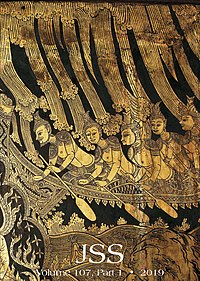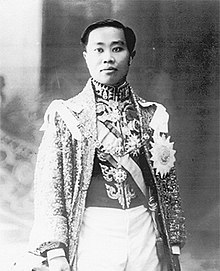 | |
| Discipline | Thai studies |
|---|---|
| Language | English |
| Publication details | |
| History | 1904–present |
| Publisher | The Siam Society Under Royal Patronage (Thailand) |
| Frequency | Biannually |
| Yes | |
| Standard abbreviations | |
| ISO 4 | J. Siam Soc. |
| Indexing | |
| ISSN | 0304-226X (print) 2651-1851 (web) |
| Links | |
The Journal of the Siam Society (JSS) is a scholarly journal published by the Siam Society in Bangkok since 1904.
History
The Journal of the Siam Society is published by The Siam Society Under Royal Patronage in Bangkok, Thailand. At the foundation of the society in 1904, the journal was launched to fulfil the society's purpose:
The objects of the Society shall be the investigation and encouragement of Art, Science and Literature in relation to Siam and neighbouring countries…. For this purpose the Society will convene meetings, at which papers bearing on the objects for which the Society is formed will be read, or lectures given…. Such papers shall, if they are accepted by the Council, be published in a Journal, and the authors of them may, by permission of the Council, republish them in a separate form.[1][2]
The first issue of the journal, dated 1904, appeared in August 1905. Publication has been continuous ever since, missing a few issues, particularly during World War II. The number of issues per year has varied between one and four, and is now standardized as two, appearing in May–June and November–December.
The journal publishes original articles of a scholarly nature, in English, on Thailand and neighbouring countries in a wide range of disciplines including archaeology, epigraphy, history, ethnology, religion, language, literature, art and architecture, and performing arts.
In 1939, when the society changed its name to the Thailand Research Society in conformity with the nationalist policies of the government of Field Marshal Plaek Phibunsongkhram,[3] the title of the journal was changed to The Journal of the Thailand Research Society from Vol. 32/1 (Sept. 1940) to Vol. 35/2 (Sept. 1944).
In 2012, the complete back-catalog of over two thousand articles and reviews was made available on the internet.[4] Since 2019, the journal has been listed on the Scopus database of academic journals.
Volume 100, published in 2012, contained 19 commissioned articles on a theme of “Protecting Siam’s Heritage,” and was published separately as a book by Silkworm Books.
Cover

The covers of the early volumes were text-only. The first pictorial cover appeared on Vol. 77/1 (1989), showing: “Detail from a Northern Thai style mural in Wat Phra Sing, Chiang Mai. Photograph by Luca Invernizzi Tettoni.”[5]
Editorship

The Rules adopted in 1904 provided for the management of the journal as follows:
A Journal shall be published, when practicable, every six months. Four of the Officers, appointed by the Council, shall form the committee of publication, charged with the editing of the Journal and the preparing of papers for publication in the same. One of the members of such Committee shall be appointed presiding officer. The Journal shall comprise a selection of the papers read before the Society, the Report of the Council and Treasurer, and such other matter as the Council may deem it expedient to publish.[6]
At the society's Annual General Meeting on 23 January 1923, it was resolved to appoint an editor for the first time: “The Council shall appoint one of their number as Editor of the Journal, who, as such, shall be responsible for the general arrangement and publication of the material selected by the Council…. Prof. Coedès the Hon. Librarian had kindly consented to become Editor.“[7]



| Editor | Years |
|---|---|
| George Cœdès | 1923–1924 |
| E. G. Sebastian | 1925 |
| George Cœdès | 1926–1928 |
| J. Burnay | 1929–1936 |
| Prince Dhani Nivat | 1938 |
| J. E. Davies | 1939–1940 |
| Prince Prem Purachatra | 1942–1946. |
| J. J. Boeles | 1947–1948 |
| Olcott H. Deming | 1949 |
| Rolland H. Bushner | 1951–1952 |
| A. R. K. Mackenzie | 1953 |
| Charles N. Spinks | 1956 |
| Cecil F. Stanford | 1958–1960 |
| Kenneth J. MacCormac | 1961–1965 |
| Larry Sternstein | 1966–1969 |
| Michael Smithies | 1970–1971 |
| Tej Bunnag | 1972–1976 |
| Kim Atkinson | 1977–1980 |
| Tej Bunnag | 1981–1985 |
| Sulak Sivaraksa | 1986–1987 |
| Kaset Pitakpaivan | 1988 |
| James V. Di Crocco | 1989–1994 |
| Pitya Bunnag | 1995–1996 |
| Ian Glover | 1997–1998 |
| Ronald D. Renard | 1999–2001 |
| Dhiravat na Pombejra | 2002–2008 |
Content and authors
Early issues printed lectures delivered at meetings of the society along with an annual report of the society's activities. Articles other than those read at meetings began to appear in the mid-1930s, along with book reviews. Early articles focused on the history of Siam and exploration of its provinces. Obituaries of prominent members became a regular feature following the obituary of Prince Damrong Rajanubhab in 1944.[8] The size of the journal shrank in the 1940s, then expanded from the mid-1950s with more articles on archeology, anthropology (especially of hill people), and other social sciences.
Before World War II


Prince Damrong Rajanubhab authored 10 articles between from the first issue in 1904 and 1939. Prince Dhani Nivat authored 17 articles between 1930 and 1965. George Cœdès authored 11 articles between 1918 and 1944. Other prolific contributors in the early years included Jean Burnay and Robert Lingat.
King Vajiravudh
In 1912, the journal carried an article by King Vajiravudh, Rama VI, on “The Romanisation of Siamese Words.” For some years, the society had discussed the need for a standard system for transcribing Thai into Roman characters. A member, P. Petithuguenin, had proposed a system.[9] In his article, King Vajiravudh proposed an alternative system, which had an “Orientalist” method for transcribing consonants in words derived from Pali-Sanskrit, a parallel and different system for transcribing consonants in “purely Siamese” words, and 30 representations of vowel sounds. The king concluded: “I should be glad to see some sort of uniform system adopted, rather than to have to endure the haphazard and fanciful systems, which not only each body of men but also each individual, seems to use for romanising my language.”[10]
After World War II
In the post-World War II period, Hans Penth authored 24 articles between 1967 and 2003, though many were short notes. The largest contributors were Michael Smithies, 22 articles between 1971 and 2002, Phraya Anuman Rajadhon, 19 articles between 1951 and 1967, and Michael Vickery, 13 articles between 1973 and 1995, including his translation of the only chronicle text discovered in the 20th century.[11] The largest span was achieved by Barend Jan Terwiel who authored 11 articles over 47 years from 1972 to 2019.
Epigraphic and Historical Studies series
Between Vol 56/2 (July 1968) and Vol. 67/2 (July 1979), JSS published 26 articles co-authored by A. B. Griswold and Prasert na Nagara. Of these, 24 were in a series of “Epigraphic and Historical Studies,” which provided the first English translations and interpretations of the corpus of inscriptions, mainly from Sukhothai and associated sites. The series was subsequently published by the Historical Society of Thailand.[12] Griswold (1906–1991) was a Baltimore native, Princeton graduate, and investment banker who was parachuted into Thailand behind Japanese lines during World War II. Prasert na Nagara (1918–2018) began his career as an agricultural engineer before discovering his talent and love for languages and history. During the creation of the series, he would spend one month a year working with Griswold at his US home.[13][14]
References
- ^ "The Foundation of the Siam Society" (PDF). Journal of the Siam Society. 1: iii. 1904.
- ^ "Rules of the Siam Society" (PDF). Journal of the Siam Society. 1: iii. 1904.
- ^ Warren, William (2004). The Siam Society: A Century. Bangkok: The Siam Society Under Royal Patronage. p. 54.
- ^ "Siam Society: 108 years now online". Bangkok Post. 2012-07-09. Retrieved 2016-12-10.
- ^ "[Cover]" (PDF). Journal of the Siam Society. 77 (1). 1989.
- ^ "Rules of the Siam Society" (PDF). Journal of the Siam Society. 1: v-vi. 1904.
- ^ "Notes of the Quarter" (PDF). Journal of the Siam Society. 17 (1): 36. 1923.
- ^ "In Memoriam" (PDF). Journal of the Siam Society. 35 (1). 1944.
- ^ Petithuguenin, P. (1912). "Method for Romanizing Siamese". Journal of the Siam Society. 9 (3).
- ^ "The Romanisation of Siamese Words by His Majesty the King". Journal of the Siam Society. 9 (4): 1–10. 1912.
- ^ Vickery, Michael (1977). "The 2/K.125 Fragment, a Lost Chronicle of Ayutthaya". Journal of the Siam Society. 65 (1).
- ^ Griswold, A.B.; Prasert na Nagara (1992). Epigraphic and Historical Studies. Bangkok: Historical Society.
- ^ "Obituary: Alexander Brown Griswold". Journal of the Siam Society. 79 (2). 1991.
- ^ "Obituary: Prasert na Nagarad". Journal of the Siam Society. 107 (2). 2019.








